Newsletter May 2022
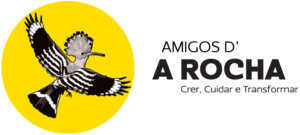
 Enjoy the beautiful flowers 🙂
Enjoy the beautiful flowers 🙂
This month find out how to reduce plastics and get to know the Turtle Dove.
Bee-eaters are here, did you already spot one?
Helen & Filipa
S
N
A
P
SHOT

Ricardo de Almeida Jorge

Portuguese doctor, researcher and teacher
Born: 9th May, 1858, Porto, Portugal
Died: 29th July, 1939, Lisboa, Portugal
Ricardo Jorge, was born in Porto on the 9th of May of 1858; lived all is childhood in Porto where he also studied in the Medical-Surgery School of Porto and graduated in 1879. His thesis was about Neurology, a subject not well known for the time. In 1880 he started to teach at the same school he graduated, Anatomy, Histology and Physiology. During this time he did some travelling to Paris and Strasburg, aiming to learn more at their local hospitals about neurology.
In 1884, he abandons the Neurology to dedicate is life to Public Health; publishes a work titled “Social Hygiene applied to the Portuguese Nation” and gave several conferences which lead him on an important career as a researcher and influencing the public health politics in Portugal. In 1895 he becomes professor of Hygiene and Legal medicine in the Medical School of Porto and in 1889 discovers the “clinical and epidemiological proof” of the bubonic plague. In 1899 he was transferred to Lisbon and in 1903 he became Director of the Institute of Central Hygiene, which was named after him in 1929 until today the National Health Institute Doctor Ricardo Jorge.
Ricardo Jorge was responsible, in the 20’s for the banning of Coca-Cola in Portugal (just allowed after 50 years). His life was dedicated as well to the Arts, Literature, History and Politics. He died at the age of 81 of an urinary infection.
IFO’s – Identified Flying Objects…

Rusty Dot Pearl
(Udea ferrugalis, Hübner, 1796)
Photo by Filipa Bragança

Morphology: It is a micro moth from the Crambidae Family, with a wingspan between 18 and 22 mm. The forewings have yellowish, brown or ferruginous ground colour with an ovoid dark mark and a kidney spot in median area; the hindwings are dark grey and the legs are whitish. The wings have a triangular shape when resting. Several generations per year. The adults can fly all year round.
Habitat: Wide variety of habitats, meadows. farmlands, woodlands, gardens and pastures.
Distribution: Europe, Asia Minor, Africa, India and Japan.
Notes: The larvae is polyphagous and feeds on plants of Asteraceae, Lamiaceae and Rosaceae Family (E.g. Stachys spp,
Arctium spp, Fragaria sp). In some places it is considered a pest because the larvae can feed on crops (E.g. soya, beet root, beans). The adults are attracted to light.
Tweet… Tweet…

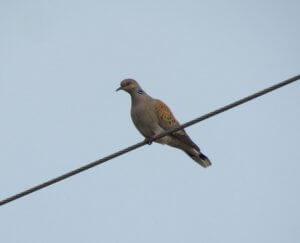
European Turtle Dove
(Streptopelia turtur, Linnaeus, 1758)
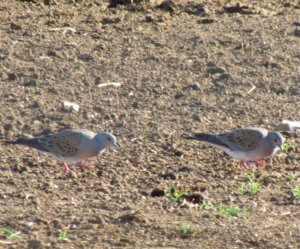
Photos by Guillaume Réthoré
Identification: It is a dove from the Columbidae Family, with a wingspan between 45 and 50 cm and 25 to 28 cm in length. Small and slim dove, the plumage is brownish above, mottled black, the breast is pinkish and the abdomen white; has distinctive black and white striped patch on the side of the neck. The bill is dark and the legs are reddish. Males and females are similar.
Habitat and Ecology: Inhabits woodlands, steppe, semi-desert areas and farmlands. The nest is built in the lower parts of trees or bushes. Feeds mainly on the ground, seeds, grains, fruits of weeds and cereals (rely on agricultural land for feeding). Migratory species, winters south of the Sahara.
Distribution: Central and Southern Europe, Central Asia, Middle East and North Africa. In Portugal it is more common in the northwest.
Threats and Notes: Vulnerable (VU) according to the Red List of the International Union for Conservation of Nature (IUCN). The species has undergone a rapid population decline, due to habitat loss, transformation in agriculture land and changes in agriculture practices, illegal hunting, and drought in winter grounds and competition with Collared Dove.
DID YOU KNOW? 
- On the 13th of April we had another Friend’s event! Lagoa Rice Fields! A beautiful walk with beautiful birds! All the people on the walk had never been in this area before, and were surprise to see strawberries and raspberries being grown in the area. Thank you Gui for another lovely outing.
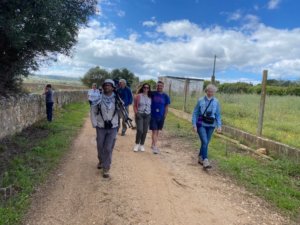
-
Daniel Pincho, is a student doing is internship at A Rocha Portugal, 21 years old, Portuguese, staying for 2 months. He is finishing his degree in Environmental Education and Nature Tourism and doing his internship in Environmental Education.
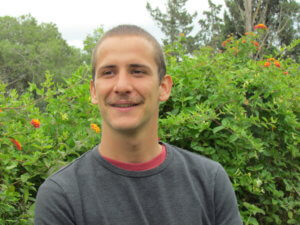
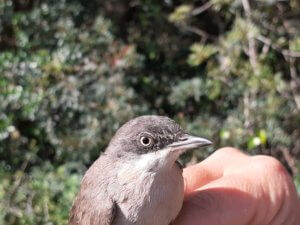
Western Orphean Warbler
-
On the 07th of April we caught a Western Orphean Warbler (Curruca hortensis), at our ringing station! The last caught was in 2016 and it is the 9th ever caught. During April we caught some migrants on their way to north: Pied Flycatcher (Ficedula hypoleuca), Garden Warbler (Sylvia borin), Nightingale (Luscinia megarhynchos) and a Western Subalpine Warbler (Curruca ibereae).
-
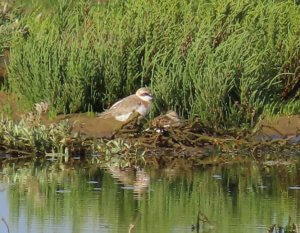
Greater Sand Plover
The Spring/Summer birds arrived! Some of the birds seen at Ria de Alvor Nature 2000 on the last days: Red-necked Nightjar (Caprimulgus rufficollis), Common Quail (Coturnix coturnix), Bee-eater (Merops apiaster), Pallid Swift (Apus pallidus), Common Swift (Apus apus), Alpine Swift (Apus melba), Western Osprey (Pandion haliaetus). Golden Oriole (Oriolus oriolus), Purple Heron (Ardea purpurea), Little Tern (Sternula albifrons), Eagle Owl (Bubo bubo) and Turtle Dove (Streptotelia turtur).
- On the 17th of April, a Portuguese birdwatcher spotted a rare species in Ria de Alvor: a Greater Sand Plover (Charadrius leschenaultii); this species breeds in the Middle East and probably lost its way due to the strong winds.This is the first time this species was seen in Ria de Alvor and in Portugal.
Friends Event: “A ‘Crafty’ Way to Recycle with Elisabete Freitas” and Lunch
11th May from 10:30 to 14:30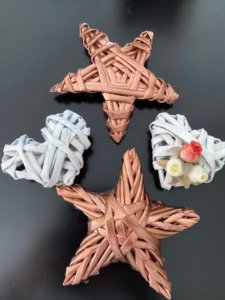
10-30 – 11.00am Coffee & Introduction
11.00 – 1.00pm Creating your own hearts, stars or maybe something else.
All products required to make these or other shapes will be provided by Elisabete. Her expertise will be shared on the morning so that by the time the morning is over, you will be able to go home and make many items of your choice. Recycled paper is the main component of these lovely designs.
1.00 – 2.30pm Lunch at Cruzinha
Ticket price – 20 Euros (Friends) 25 Euros (Non Friends)
 INVASIVE SPECIES
INVASIVE SPECIES
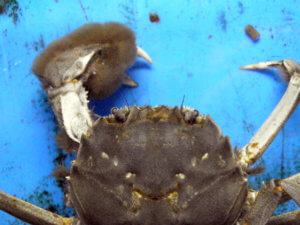
image downloaded from Naturdata
Chinese Mitten Crab (Eriocheir sinensis, H. Milne-Edwards, 1853)
Phyllum: Arthropoda
Class: Malacostraca
Family: Varunidae
Origin: East Asia (from Korea to China)
Size: 5 to 7 cm (size of the carapace), maximum 10 cm
The Chinese Mitten Crab is a medium size crab, has square shaped carapace (distinguished from other European species) and hair-like covering on the fore claws (well developed in males). The colour varies from brownish to yellow on the upper side and whitish underneath. The juveniles are very small; after reaching a size of 2 cm, it is possible to distinguish males from females by the shape of the abdomen, which is rounded in the female and occupies most of the area of the thorax and narrow and shaped like an inverted funnel in males.

image downloaded from Wilder
This species spends most part of its life in fresh or brackish water and can tolerate wide variations of salinity. The adults migrate downstream, in fall, to reproduce in salt or brackish waters. Females carry the eggs and after hatching, larvae are planktonic for 1 or 2 months. During this marine free-swimming phase, larvae pass through a series of development stages. At the end of summer larvae metamorphosis into juvenile crabs that settle in the bottom and migrate upstream to fresh water.
The Chinese Mitten Crab is omnivorous and opportunistic, feeds on a wide variety of food, according to the food availability: plant matter, invertebrates, fish and molluscs (sea shells). This species moves from fresh water habitats (juveniles) to salt water habitats in order to reproduce; occupies different ecosystems according to its life stage (estuaries, bays and rivers).
The pathway of invasion, probably was in water tanks of commercial ships. This species was first recorded in Europe in 1912, in Germany and in 1992 arrived to USA and in 1999 was already in Western Europe. In Portugal it is present in Tagus and Minho River. According to the IUCN (International Union for the Conservation of Nature) is among the 100 worst invasive species of the world, because it causes a negative impact in the ecosystems, completion with native species and reduction in biodiversity.
POPPED UP

Family: Asteraceae
Identification: It is an annual herbaceous plant, can grow between 20 and 30 in height. The stem is branched, hairy with small green leaves, alternated, sessile and oblong or lance-shaped. The inflorescence is a single flower head, growing at the top of the stem, yellow to orange-yellow. The fruit is an achene. Flowers from October to June.
Habitat and distribution: Meadows, pastures, farmlands, grasslands, wastelands and road sides. It is native from the Central and Southern Europe.

Photo by Filipa Bragança
Field Marigot (Calendula arvensis, (Vaill. (L.))
Notes: The flowers have several medicinal uses, it is used externally as an anti-inflammatory, for bites and stings. This species is used as ornamental. This species is very similar to Calendula suffruticosa, which is more common in coastal areas.
DATES TO REMEMBER

1st of May – Workers Day (National Holiday) and Mothering Sunday
5th, 12th, 19th, 26th May – Cruzinha Bird ringing display & Moth Talk (10 am to 12 am). Book here
11th May – Friends Event (see information above)
26th May – Ascension Day/ Stalk Day
Thank you for supporting the Friends of A Rocha Portugal
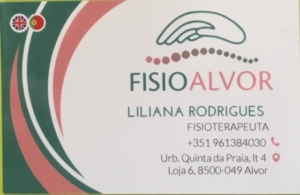
Physiotherapy, Massages (relaxation, sports, therapeutic)
Other therapies
Beauty (manicure, pedicure, hair removal, facials)
Open Monday to Friday

Dr Roy Rodrigues
Av. Do Brasil, Qta das Palmeiras, Lt P2, R/c A, 8500-299 Portimão
(+351) 282180683
royaldente@gmail.com
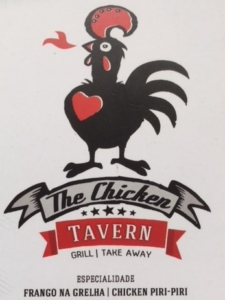
Urbanização Mar e Serra n° 47, Alvor
8500 – 783 Portimão
(+351) 911597735
Thought of the month 
“Never doubt that a small group of thoughtful, committed citizens can change the world; indeed, it is the only thing that ever has.”
—Margaret Mead (1901 – 1978) American cultural anthropologist & author

LETS BE GREEN – LETS BE GREEN – LETS BE GREEN 
REDUCE PLASTIC NOW!
The plastic waste island floating in the Pacific now measures 1,6 million Km2!!!
- Avoid single-used plastic such has drinking straws, plates, cutlery
- Use cloth bags for your shopping
- Buy more bulk food and fewer packaged products
- Replace plastic Tupperware for glass or steel containers
- Use wooden pegs for hanging out your washing instead plastic ones
- Avoid using cosmetics with microplastics
- Use biodegradable brushs and use natural fabrics
- Recycle your plastic
- Make those around you aware of the importance of reducing the consumption of plastic
LETS BE GREEN – LETS BE GREEN – LETS BE GREEN
Moth Monitoring
Moth monitoring at A Rocha began in 1991, by placing a light trap in Cruzinha garden (A Rocha Centre). Once a week the trap is opened overnight and moths are registered the next morning. Since 2004, the person in charge of the moth monitoring is Paula Banza, PhD. Over the years more than 600 species of moths have been identified at our site.
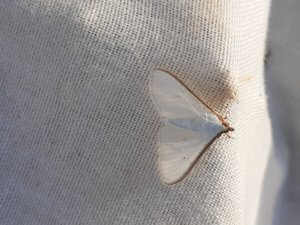
Jasmine Moth

Shuttle-shaped Dart
In 2021, 39 sessions were held and 9361 individuals of 362 species were captured, belonging to 35 different families. There were 13 new species identified, although some species are still waiting confirmation of the identification, as additional analysis is required.
The most common species in 2021 were: Hoary footman (Eilema caniola), Ethmia bipunctella, Large Yellow Underwing (Noctua pronuba), Jasmine Moth (Palpita vitrealis) and Shuttle-shaped Dart (Agrotis puta).
On the A Rocha website, it is possible to read the reports of moth monitoring since 2014.
Read the full report of 2021 here
Climate change – birds
Climate change has a direct impact on human’s life and in the same way on wild life. The impact of climate change on birds is changing phenology, distribution and abundance of some species. Recent studies reveal that bird’s species which benefit from climate change have increased in abundance since the 1980’s, while species which do not benefit are decreasing; although there are three more times bird’s species negatively affected by climate change than are positively affected. In Europe, around 75% of the birds studied may have been negatively impacted by climate change.
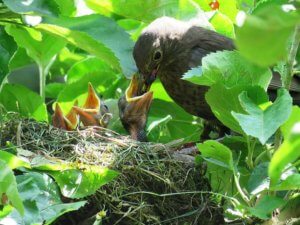 According to another study, climate warming is causing changes in birds nesting dates, decreasing chick numbers and even body sizes. The study was done with 60 European bird species and focuses on egg-laying, body form and number of off-spring; the impacts were caused by higher temperatures but as well by other factors (non-temperature related), like habitat loss, pollution, invasive species and diseases. More than 57% of the impacts were caused by increasing temperatures, 86% of the birds experienced a shift in egg-laying dates and 32% experienced body changes due to heat stress.
According to another study, climate warming is causing changes in birds nesting dates, decreasing chick numbers and even body sizes. The study was done with 60 European bird species and focuses on egg-laying, body form and number of off-spring; the impacts were caused by higher temperatures but as well by other factors (non-temperature related), like habitat loss, pollution, invasive species and diseases. More than 57% of the impacts were caused by increasing temperatures, 86% of the birds experienced a shift in egg-laying dates and 32% experienced body changes due to heat stress.
The breeding ranges of the European birds are also likely to shift north-eastwards due to climate warming. A model was used to project the areas which will be more suitable for bird species under future climate scenarios. The projections show an increase in diversity in the Artic Region and a decrease in southern and western parts of Europe.
Sustainability Champions 
Sustainability Champions from around the World– Looking at ways to curb pollution and waste management.
We would like to thank Daniel Hartz, the founder of Sustainability Champions for giving us the permission to share this information.
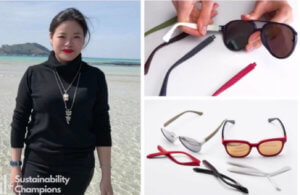 Stella Tong and Aedy Choi (not in the image) who have over 15 years of expertise, started to design eyewear from ocean plastic without metal components. Ecofinity by Agile Eyewear, based in Hong Kong was created by a group of enthusiastic and ecologically conscience professionals from the eyewear industry. They wanted to revolutionize the market, safeguard our beautiful planet, and help to provide a better living environment for our children. So they created a 100% sustainable eyewear made from recovered ocean plastics, which have a revolutionary, interchangeable design.
Stella Tong and Aedy Choi (not in the image) who have over 15 years of expertise, started to design eyewear from ocean plastic without metal components. Ecofinity by Agile Eyewear, based in Hong Kong was created by a group of enthusiastic and ecologically conscience professionals from the eyewear industry. They wanted to revolutionize the market, safeguard our beautiful planet, and help to provide a better living environment for our children. So they created a 100% sustainable eyewear made from recovered ocean plastics, which have a revolutionary, interchangeable design.
The recycled plastic supplier is Tide Ocean Material, a company established in Basil, Switzerland, which upcycles ocean-bound plastic trash into premium raw material that brands use, to build sustainable products.
For every pair of Ecofinity sunglasses, 3 plastic bottles are removed from the ocean – a sure way to help the solution to ocean pollution!

SPEA has a new online shop
 The Portuguese Society for the Study of Birds (SPEA) has a new online space for your shopping needs. Invest in a pair of binoculars, stay up-to-date with the latest bird guides, find inspiration in a field guide or get a Nature-themed gift; you’ll be helping to protect birds and their habitats.
The Portuguese Society for the Study of Birds (SPEA) has a new online space for your shopping needs. Invest in a pair of binoculars, stay up-to-date with the latest bird guides, find inspiration in a field guide or get a Nature-themed gift; you’ll be helping to protect birds and their habitats.
Go shopping here

Check the website for dates for organised tours
Guillaume Réthoré (Gui)- My life with birds: Ring-billed Gull (Larus delawarensis)
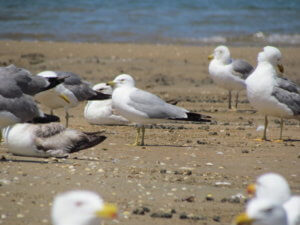 Few people like gulls and many don’t really pay attention to them. For the birdwatchers, they are puzzling and their identification can be difficult. However, finding a rare or uncommon gull is always rewarding.
Few people like gulls and many don’t really pay attention to them. For the birdwatchers, they are puzzling and their identification can be difficult. However, finding a rare or uncommon gull is always rewarding.
A few years ago, in January, I found a Ring-billed Gull at Lagoa dos Salgados. This bird was in its 1st winter (or 2nd calendar year) and stayed there a few weeks. Later the same year, the same bird was found at the same place. Since it was December, this bird was in its 2nd winter. It spent the winter at Lagoa dos Salgados until it disappeared. So far, I had seen this bird several times, but never in its adult plumage. In May, while visiting Portimão harbour and looking for rings, I saw this gull and thought “Gulls are a difficult group, this bird is much smaller than the others but they are all the same species!”. I soon realized my mistake! As I got a closer look at this bird, I saw its yellow ringed-bill! An adult Ring-billed Gull, possibly the same bird that spent the winter at Lagoa dos Salgados.
Can you spot it in the picture?
Text and photo by Guillaume Réthoré
Editor: Filipa Bragança
English proof reading: Helen Rodda
Portuguese proof reading: Lena Soares
Production controller: Helen Rodda
Email: friends.arpt@arocha.org
Thank you for supporting us!
Hope to see you soon!


 What makes a good Birthday present?
What makes a good Birthday present?

